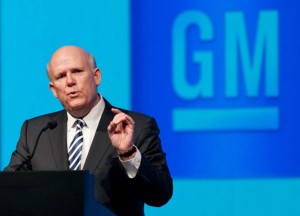Soon-to-retire General Motors Chairman and CEO Dan Akerson has said thanks, but no thanks, to suggestions the now-profitable automaker should pay back the roughly $10 billion the U.S. Treasury is believed to have lost on its 2009 bailout of the then-bankrupt automaker.
Speaking at the National Press Club in Washington, D.C., Akerson told his audience that the government took a risk like any other investor – including those wiped out when GM filed for Chapter 11 protection. And, the CEO stressed, the bailout was far less expensive than the tens of billions of dollars in lost taxes and other revenues that would have been lost if GM had gone out of business.
“I would not accept the premise that this was a bad deal,” said Akerson, who plans to retire on January 15, when his protégé Mary Barra becomes the first woman CEO at a major auto manufacturer. “The die was cast” when the government decided to take shares rather than make its investment in the form of a loan, Akerson emphasized.
Akerson’s comments came almost simultaneously with an announcement made in Flint, Michigan – the birthplace of General Motors – where the maker revealed plans to invest $1.3 billion in five Midwest plants, a move that it expects will create 1,000 new jobs. Since 2009, the maker has announced investments of more than $10.1 billion in its U.S. operations — $2.8 billion in 2013 alone — creating or retaining more than 26,500 jobs.
(Click Here for more on the latest expansion plans.)
A study by the Michigan-based Center for Automotive Research last week estimated that in 2009 alone, the bailout saved about $40 billion in federal revenues and over 1 million U.S. jobs, heading off what potentially could have become a full-scale depression. Nonetheless, the high cost of the bailout remains a controversial issue, especially among conservatives who have derided the automaker as “Government Motors.”
(Click Here for more on the CAR study.)
During his speech to the National Press Club, Akerson outlined the steps GM has taken and painted a positive image of where the company has come in less than five years since emerging from bankruptcy protection – no easy challenge considering, “We’ve been trying to fix this airplane while in the air,” he said.
(U.S. sells off last stake in GM. Click Here for details.)
There have been some setbacks. The maker has had to largely back away from a proposed alliance with troubled French automaker PSA Peugeot Citroen, and it this month announced plans to pull the Chevrolet brand out of Europe to focus on the core Opel brand. On the other hand, GM’s European turnaround plan is beginning to show some traction after more than a dozen years of severe losses.
And after watching its U.S. market share slide for much of the last decade, GM expects to end 2013 with a modest increase – something that reflects the overwhelmingly positive response to a wave of new products including the new Chevrolet Corvette and Silverado models, along with the 2014 Cadillac CTS, all of which are finalists in the widely followed competition for North American Car and Truck of the Year.
(Akerson to retire, Barra to become first woman CEO. Click Here for the full story.)
GM is hoping to counter concerns of industry analysts who expect it to continue losing share in an increasingly competitive market as it boosts investments in both products and plants. But a critical difference between the GM that went into Chapter 11 and the maker of today is that it can earn money in a smaller market with a lower market share.


Proof that our government is even dumber than GM executives who got themselves into bankruptcy thru bad decisions. ALL should be held accountable for defrauding U.S. tax payers out of $10.5 BILLION plus interest.
There needs to be a more holistic accounting of the GM rescue. Failure of GM would have brought the world auto industry to its knees, pure and simple.
However, the optics of GM saying “tough rocks”, while certainly within their rights is a bad move that will leave a bad taste with taxpayers.
When Chrysler repaid their first loan in the 80’s, it was virtually a national holiday. The clear message was, “thanks America, we got this now.” GM could help themselves enormously in good will and PR with quarterly set-asides to the Treasury (imagine that photo op) designed to close the gap.
As someone told our kids: Character is what you do when you don’t have to, or no one is looking.
The U.S. economy would have suffered from a total closure of GM but it would have survived. GM however would not have survived without a U.S. tax payer LOAN. If the Feds are so incompetent as to make a deal with GM that does NOT include complete repayment of the loan with interest, then they have defrauded America and both GM and the Feds should be personally held accountable for criminal fraud and full repayment of the debt.